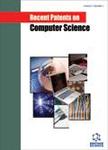版权所有:内蒙古大学图书馆 技术提供:维普资讯• 智图
内蒙古自治区呼和浩特市赛罕区大学西街235号 邮编: 010021

作者机构:Department Computer Applications and Creative Media School of Information Technology and Engineering Vellore Institute of Technology Vellore India
出 版 物:《Recent Patents on Computer Science》 (Recent Pat. Comput. Sci.)
年 卷 期:2019年第12卷第1期
页 面:18-24页
核心收录:
学科分类:12[管理学] 0808[工学-电气工程] 0809[工学-电子科学与技术(可授工学、理学学位)] 08[工学] 0810[工学-信息与通信工程] 1205[管理学-图书情报与档案管理] 1201[管理学-管理科学与工程(可授管理学、工学学位)] 0835[工学-软件工程] 0813[工学-建筑学] 0714[理学-统计学(可授理学、经济学学位)] 0814[工学-土木工程] 0701[理学-数学] 0812[工学-计算机科学与技术(可授工学、理学学位)]
基 金:This research work is carried out with initial motivation from (Late) Dr. V.K. Ananthshayana. Heartily Thankful to Faculty Member of School of Social Science and Languages at VIT Vellore (who are professional language editor for any grammatical semantical/stylistic and typographical errors) for giving their valuable time in correcting this research article
主 题:Principal component analysis
摘 要:Background: A physical object, which is actually in 3D form, is captured by a sen-sor/camera (in case of computer vision) and seen by a human eye (in case of a human vision). When someone is observing something, many other things are also involved there which make it more challenging to recognize. After capturing such a thing by a camera or sensor, a digital image is formed which is nothing other than a bunch of pixels. It is becoming important to know that how a computer understands images. Objective: This paper is for highlighting novel techniques on 3D object recognition system with local shape descriptors and depth data analysis. Methods: The proposed work is applied to RGBD and COIL-100 datasets and this is of four-fold as preprocessing, feature generation, dimensionality reduction, and classification. The first stage of preprocessing is smoothing by 2D median filtering on the depth (Z-value) and registration by orientation correction on 3D object data. The next stage is of feature generation and having two phases of shape map generation with shape index map and SIFT/SURF descriptors. The dimensionality reduction is the third stage of this proposed work where linear discriminant analysis and principal component analysis are used. The final stage is fused on classification. Results: Here, calculation of the discriminative subspace for the training set, testing of object data and classification is done by comparing target and query data with different aspects for finding proper matching tasks. Conclusion: This concludes with new proposed approach of 3D Object Recognition. The local shape descriptors are used for 3D object recognition system to implement and test. This system is achieves 89.2% accuracy for Columbia object image library-100 images by using local shape descriptors. © 2019 Bentham Science Publishers.